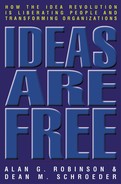NOTES
Chapter 1
1. Friedrich Hayek, “The Use of Knowledge in Society,” American Economic Review 35, no. 4 (September 1945): 519-30.
2. “Modernizing Government,” British government white paper, March 1999, 62.
3. For more on the I-Power system, see Martin Edelston and Marion Buhagiar’s book, I-Power: The Very Simple Secret of Business Success (Greenwich, CT: Greenwich Institute for American Education, 1992).
Chapter 2
1. George Stalk and Thomas Hout, Competing against Time (New York: Free Press, 1990), 76.
2. Stalk and Hout, Competing against Time, 77.
3. James Abegglen and George Stalk, Kaisha: The Japanese Corporation (New York: Basic Books, 1985).
4. The National Annual Report on Japanese Kaizen Teian Systems (Tokyo: Japan Human Relations Association, November 1997), and the 1985 Annual Statistical Report of the National Association of Suggestion Systems (Chicago: National Association of Suggestion Systems, 1985). The U.S. data are reported for the 1985 calendar year, the Japanese data for the 1986 fiscal year (April 1, 1985, to March 31, 1986). Savings for both countries are given in U.S. dollars at the exchange rate of $1 = 130 yen.220
5. Peter Senge, The Fifth Discipline (New York: Currency Double-day, 1990).
6. Chris Argyris and Donald A. Schön, Organizational Learning (New York: Addison-Wesley, 1978).
7. This point has made by a number of people. See, for example, Robert W. Weisberg, Creativity: Beyond the Myth of Genius (New York: Freeman, 1993).
8. Allan Nevins papers. Quoted from Ron Chernow, Titan: The Life of John D. Rockefeller, Sr. (New York: Random House, 1998), 180.
9. Julian Richer, The Richer Way (London: Emap Business Communications, 1995).
Chapter 3
1. Alfie Kohn, Punished by Rewards: The Trouble with Gold Stars, Incentive Plans, A’s, Praise, and Other Bribes (New York: Houghton Mifflin, 1993), 17.
2. Steven Kerr, “On the Folly of Rewarding A, While Hoping for B,” Academy of Management Executive 9, no. 1 (1995): 7.
3. Sources: The National Annual Report on Japanese Kaizen Teian Systems (in Japanese) (Tokyo: Japan Human Relations Association, November 1992), and the 1989 Annual Statistical Report of the National Association of Suggestion Systems (Chicago: National Association of Suggestion Systems, 1989). The U.S. data are reported for the 1989 calendar year, the Japanese data for the 1989 fiscal year (April 1, 1988, to March 31, 1989). Savings for both countries are given in U.S. dollars at the exchange rate of $1 = 130 yen.
4. This story is based on interviews with James Lisec (Krishan Jagga died in the early 1990s), on documents he sent us, on two articles about this court case in the Wall Street Journal (the front-page article in the February 23, 1976 issue and the short article about the wrongful discharge lawsuit in the November 8, 1985 issue, p. 10), and on the California Appeals Court decision James K. Lisec et al. v. United Airlines Inc. (1978) 85 Cal. App. 3d 969, and California Appeals Court decision James K. Lisec et al. v. United Airlines Inc. (1992) 10 Cal. App. 4th 1500, p. 2.221
5. California Appeals Court decision James K. Lisec et al. v. United Airlines Inc. (1992) 10 Cal. App. 4th 1500, p. 2.
Chapter 4
1. Frederick Taylor, The Principles of Scientific Management (New York: Harper 1911; reprinted by Hive Publishing Company, Easton, Pennsylvania, 1985, p. 38.
2. Frederick Taylor, “Boxley Talk,” June 4, 1907, Taylor Collection, Samuel C. Williams Library, Stevens Institute of Technology, Hoboken, NJ, p. 3. We are grateful to Robert Kanigel for alerting us to this quote in his book The One Best Way (New York: Viking, 1997), 169.
3. Martin Edelston and Marion Buhagiar, I-Power: The Secrets of Great Business in Bad Times (Greenwich, CT: Boardroom Books, 1992).
4. W. G. Dauphinais and C. Price, eds., Straight from the CEO (New York: Simon & Schuster, 1998), 243.
5. The source for the information in this paragraph is Toyota: A History of the First Fifty Years (Toyota City, Japan: Toyota Motor Corporation, 1988).
Chapter 5
1. G. W. Dauphinais and C. Price, eds., Straight from the CEO (New York: Simon & Schuster, 1998).
Chapter 7
1. Michael Gelb, How to Think Like Leonardo da Vinci (New York: Delacorte, 1998), 57.
2. In a somewhat distasteful experiment, a consulting company actually tried this with live frogs, and it didn’t work as advertised.
Chapter 8
1. Lucas Frederick Sterne, “A Historical and Critical Analysis of Employee Suggestion Systems in American Industry,” Ph.D. dissertation, University of Iowa, 1944, 29.
